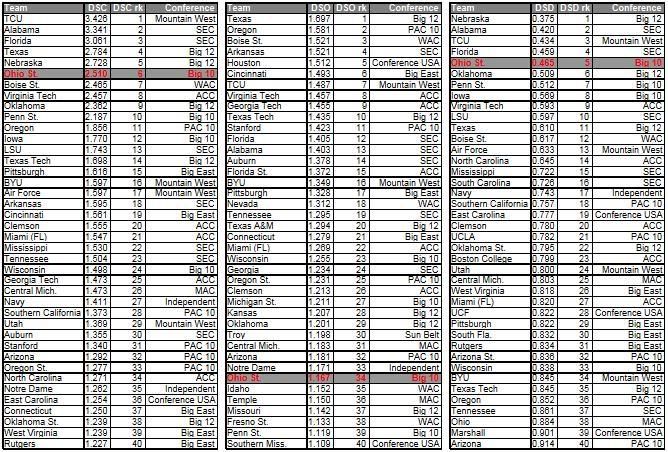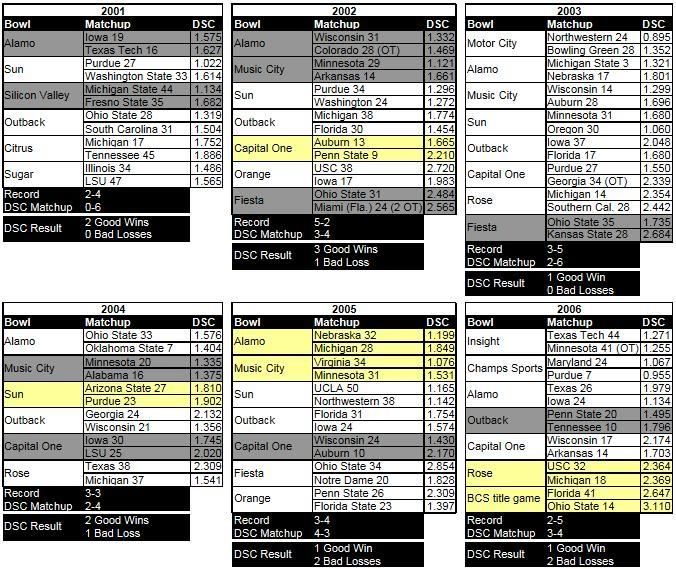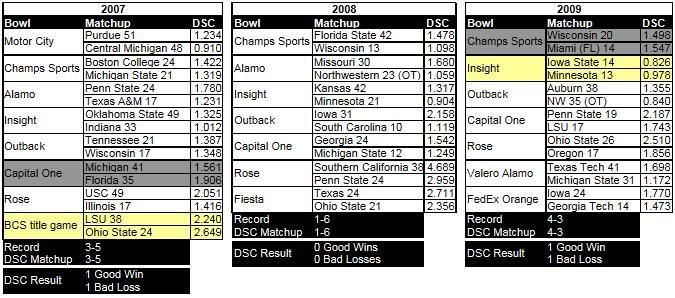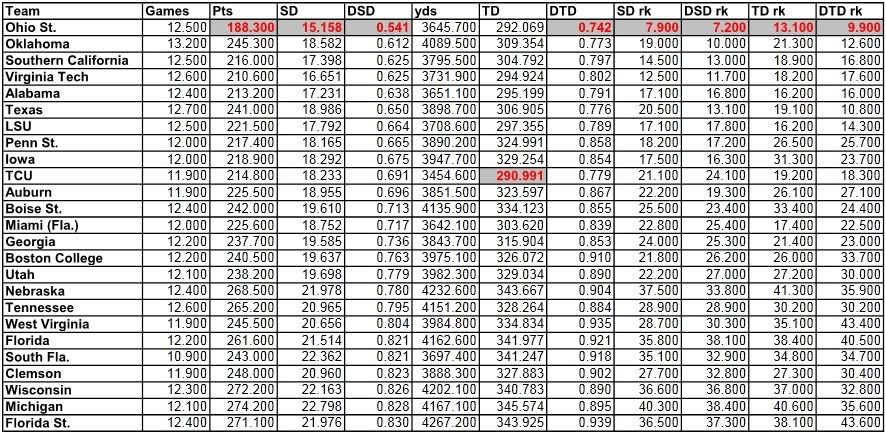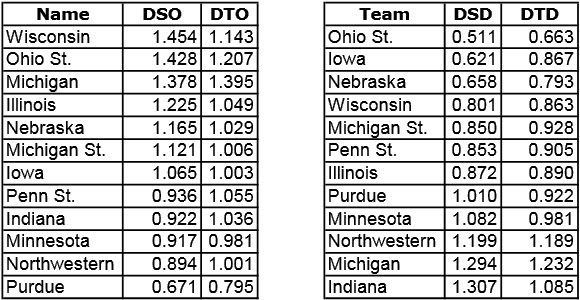smithlabs;1634257; said:
It seems like DSC works pretty well. I would be way cool if DBB or somebody else would do a little revisionist history in the off season. The Big 10 has taken some flack for their recent bowl record, despite sending two teams to the BCS. Two teams in the BCS means that there are tougher match ups across the board. Tougher match ups should told by the DSC. Bottom line, did the Big 10 lose many games they weren't suppose to (per DSC) in recent bowl history?
Good question...
In the tables below (labeled by season, not calendar year), "DSC Matchup" indicates the record that the Big-10 would have had if the team with the higher DSC number won every game. A "Good Win" then, is a Big 10 win over an opponent with a higher DSC, and a "Bad Loss" is to an opponent with a lower DSC.
"Good Wins" are highlighted in Grey
"Bad Losses" are highlighted in Maize
Overall, the conference has 12 Good Wins and 8 Bad Losses; with 43 games that went according to Hoyle. Not too shabby...
overall.
But look at how the record was compiled.
- 2001-2004: More Good Wins than Bad Losses every year
- 8 Good Wins (3 vs. SEC)
- 2 Bad Losses (1 vs. SEC)
- Buckeyes get two good wins
- 2005-2006:

- 2 Good Wins (Both vs. SEC)
- 4 Bad Losses (1 vs. SEC)
- No Show in Glendale
- 2007-2009: meh
- 2 Good Wins (1 vs. SEC)
- 2 Bad Losses (1 vs. SEC)
- '07 NC game (Played Jan08) was a bad loss with an asterisk
- LSU had crazy differential numbers when Glenn Dorsey was healthy, which he was for the NC game.
Good Wins and Bad Losses are usually more about the under-performance of the favorite than anything else. Where DSC is different by only a tenth of a point or so a favorite can be excused for being within the margin of error of the data.
Many of the other under-performances (DSC-wise) have fairly easy explanations.
Reason #1: Conference Disparity:
- MSU over Fresno in '01
- Wiscy over Miami in '09 (Small DSC difference, but the game was physically dominated by the Badgers)
Reason #2: Irritable Bowl Syndrome (IBS). IBS occurs when a team thinks they are too good for the bowl they're in:
- Arkansas and Penn State in '02 - The 'Nits really thought they belonged in a BCS Bowl
- Kansas State in '03 (there may also have been a bit of conference disparity at work here)
- Iowa's miracle over LSU in '04?
- TSUN, Minnesota and Auburn in '05
- The Wolverines had the highest DSC of any team to play in the Alamo Bowl in the last 9 years, with one exception. Texas had a huge DSC advantage over Iowa in '06 and squeaked out a 2 point win.
- Minnesota '05 and Arkansas '02 were the only teams to play in the Motor City Bowl with a DSC over 1.5. Both lost due to IBS.
- Auburn had gone undefeated to no avail in '04 and was snubbed by the BCS in '05. They pulled a no-show in the Cap One and were physically dominated by a team with a much lower DSC.
Reason #3: Garden Variety over-confidence
- 2002 NC game (Jan03): Miami's DSC wasn't that much higher than Ohio State's. They only thought they were much better.
- Glendale - over-confidence was only part of the story. We need not delve into the rest. Suffice to say there were plenty of reasons why this is one of the bigger no-shows of the past 9 years that didn't involve IBS.
Reason #4: Not an under-performance at all. Sometimes an underdog wins because they finally are playing up to their potential.
- TSUN - 2007 season: In Lloyd Carr's final game, they finally played like they were capable of playing to send him out the right way.
- LSU - 2007 season: When Glenn Dorsey was healthy, the Tigers really were All That
Conclusion:
Sometimes it is reasonable to claim that a team didn't show up; sometimes it isn't. DSC can usually tell which is which.



